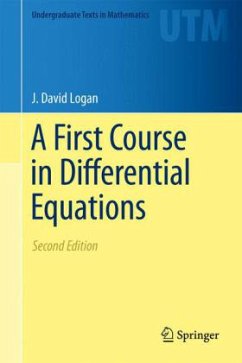This concise and up-to-date textbook is designed for the standard sophomore course in differential equations. It treats the basic ideas, models, and solution methods in a user friendly format that is accessible to engineers, scientists, economists, and mathematics majors. It emphasizes analytical, graphical, and numerical techniques, and it provides the tools needed by students to continue to the next level in applying the methods to more advanced problems. There is a strong connection to applications with motivations in mechanics and heat transfer, circuits, biology, economics, chemical reactors, and other areas.
Exceeding the first edition by over one-hundred pages, this new edition has a large increase in the number of worked examples and practice exercises, and it continues to provide templates for MATLAB and Maple commands and codes that are useful in differential equations. Sample examination questions are included for students and instructors. Solutions of many of the exercises are contained in an appendix. Moreover, the text contains a new, elementary chapter on systems of differential equations, both linear and nonlinear, that introduces key ideas without matrix analysis. Two subsequent chapters treat systems in a more formal way.
Briefly, the topics include:
First-order equations: separable, linear, autonomous, and bifurcation phenomena;
Second-order linear homogeneous and non-homogeneous equations;
Laplace transforms; and
Linear and nonlinear systems, and phase plane properties.
Exceeding the first edition by over one-hundred pages, this new edition has a large increase in the number of worked examples and practice exercises, and it continues to provide templates for MATLAB and Maple commands and codes that are useful in differential equations. Sample examination questions are included for students and instructors. Solutions of many of the exercises are contained in an appendix. Moreover, the text contains a new, elementary chapter on systems of differential equations, both linear and nonlinear, that introduces key ideas without matrix analysis. Two subsequent chapters treat systems in a more formal way.
Briefly, the topics include:
First-order equations: separable, linear, autonomous, and bifurcation phenomena;
Second-order linear homogeneous and non-homogeneous equations;
Laplace transforms; and
Linear and nonlinear systems, and phase plane properties.
From the reviews:
"Logan has produced a well-crafted text, densely packed with interesting applications from diverse fields. The chapters cover (ordinary) differential equations, analytical solutions and approximations, second-order differential equations, Laplace transforms, linear and nonlinear systems. The material is well presented and introduces new concepts ... . The text will certainly provide a good mental workout." (Christopher Howls, The Times Higher Education Supplement, November, 2006)
"This is a textbook for those who ... want to learn some methods and techniques to handle mathematical models described by ordinary differential equations. ... the book contains topics which are not included in other similar texts. ... In addition, four appendices are added to complete the presentation ... . The book is written in a pleasant and friendly style. It provides the reader with enough knowledge to engage with more advanced topics of differential equations ... ." (Gheorghe Morosanu, Zentralblatt MATH, Vol. 1088 (14), 2006)
"This text book provides an introduction into ordinary differential equations on a post-calculus level. Its primary goal is a brief and concise ... treatment of the basic ideas, models and solution methods. This goal is reached by a clever selection of the core material. The main text is written in an colloquial and friendly style and supplemented with many exercises and some appendices which among other things cover the use of computer algebra systems as well as solutions to selected exercises." (R. Steinbauer, Monatshefte für Mathematik, Vol. 154 (1), May, 2008)
"Logan has produced a well-crafted text, densely packed with interesting applications from diverse fields. The chapters cover (ordinary) differential equations, analytical solutions and approximations, second-order differential equations, Laplace transforms, linear and nonlinear systems. The material is well presented and introduces new concepts ... . The text will certainly provide a good mental workout." (Christopher Howls, The Times Higher Education Supplement, November, 2006)
"This is a textbook for those who ... want to learn some methods and techniques to handle mathematical models described by ordinary differential equations. ... the book contains topics which are not included in other similar texts. ... In addition, four appendices are added to complete the presentation ... . The book is written in a pleasant and friendly style. It provides the reader with enough knowledge to engage with more advanced topics of differential equations ... ." (Gheorghe Morosanu, Zentralblatt MATH, Vol. 1088 (14), 2006)
"This text book provides an introduction into ordinary differential equations on a post-calculus level. Its primary goal is a brief and concise ... treatment of the basic ideas, models and solution methods. This goal is reached by a clever selection of the core material. The main text is written in an colloquial and friendly style and supplemented with many exercises and some appendices which among other things cover the use of computer algebra systems as well as solutions to selected exercises." (R. Steinbauer, Monatshefte für Mathematik, Vol. 154 (1), May, 2008)

